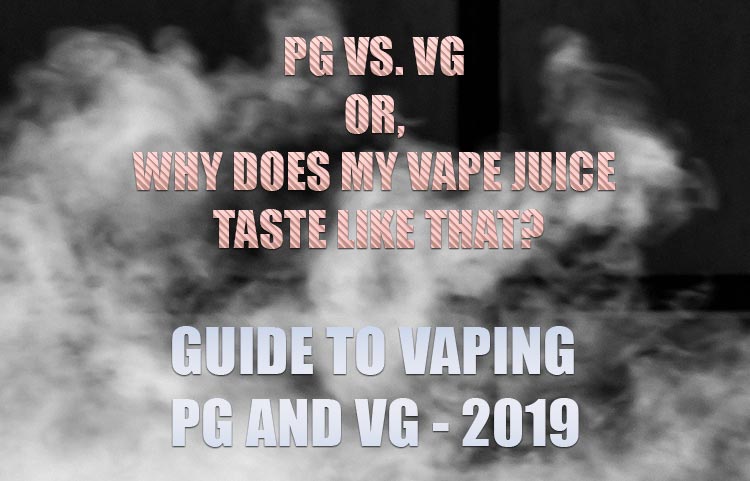Table of Contents
If you’re new to vaping or even if you’ve been around for a while, it’s important to know and understand the differences and similarities between PG and VG. While most juices were once primarily or entirely comprised of PG, nearly all modern Vape Juices are a mixture of the two, with varying ratios. So, what are these things?

PG is propylene glycol and VG is vegetable glycerin. Both of these form the basis for most vape juices, along with the other main ingredients: water, nicotine, and flavoring. While each of these ingredients has an impact on the overall flavor profile of the juice, the VG/PG ratio is arguably the most important. Both VG and PG are odorless, semi-viscous liquids. Each of them are rated safe for consumption by the FDA and commonly found in various consumer items like food and beauty products. They each technically belong to a family of chemicals called “sugar alcohols” – no, they’re not going to get you drunk nor are they going to screw up your keto diet, don’t worry; it’s just their classification. Importantly, both PG and VG are not oils and, as such, do not pose the same health risks as inhaling oil vapor.
So let’s break down the various differences between each of these, starting with propylene glycol.
PG – The Once and Future King
Propylene glycol was once the reigning king of e-juices. Although it has ceded that crown slightly to its hip new cousin, VG, it’s still a vital component in 95% of vape juice. As a byproduct of petroleum, propylene glycol is commonly found in household items like toothpaste, medical products, and various beauty products.
Chemical Properties – PG is odorless, colorless, and tasteless, making it an excellent vessel for suspension of nicotine and food flavoring. It’s also thinner, which makes it more easily absorbed by your coils and much slower to clog them.
Flavor & Throat Hit – As mentioned above, PG is flavorless but it retains flavor extremely well. When used in vape juice, this tendency leads to much more flavorful and punchy e-juices. It also produces a much more “cigarette-like” hit in comparison with the smoother hit of VG, which is great for those trying to quit smoking.
Vapor Production – Does not produce a great deal of vapor, unlike VG. This makes it great for stealth vaping set-ups or people who just prefer a bit of discretion when vaping.
Allergies and “Health Risks” – PG has been known to trigger an allergic reaction in some people. Although this is exceedingly rare, the number of people who suffer mild irritation is slightly higher. Irritation usually takes the form of a mild rash or profound dehydration. In either case, it’s probably best to stick with VG. There was also a myth going around that PG is the main ingredient in anti-freeze. While this is technically true, it’s vital to note that it’s used exclusively in non-toxic anti-freeze. The toxic variety of anti-freeze is the kind that is lethal to humans and does not contain PG. As stated before, PG is perfectly safe for human consumption, with the exception of a rare allergic reaction.
VG – The Challenger
Vegetable glycerin is found in all kinds of products, from food sweeteners to additives in baked goods which helps keep them moist. In fact, it is derived from vegetable oil, which makes this a relatively natural alternative to PG. That having been said, there are some pros and cons to consider.
Chemical Properties – As mentioned above, this is a natural derivative of vegetable oil. As such, it is naturally much thicker than PG and also has a bit of a sweet flavor to it. This works well when VG is used with sweet, heavy flavors but can become distracting in flavors like tobacco.
Flavor & Throat Hit – Vegetable glycerin is not as versatile as PG, in that it tends to mute flavors suspended in it. While it produces less flavor, it also offers a much smoother hit which many people find preferable – especially those who have been vaping for a while.
Vapor Production – This is where VG truly shines. If you’re the kind of person looking to blow massive clouds or win your local vape competition, you need a heavily VG-based vape juice. The thickness of this substance lends itself to really thick and long-lasting vapor clouds. Great for cloudchasing, terrible for stealth vaping.
Impact on Vapes – While the primary issue with PG is the potential for allergies, VG has a different drawback: it gunks up coils quickly. VG’s viscosity makes it difficult for many coils to completely vaporize, leaving residue which can quickly build up. This build-up tends to reduce the lifespan of your atomizer. Additionally, thick VG fluids take a bit longer for coils to absorb, requiring a longer break-in period for new coils.
Do We Have to Choose Only One?
The answer to this question is, of course, no. Almost all vape juices today use a combination of both, but you should take a few factors into consideration when choosing your ratio.
Most importantly, consider your set-up. If you’re using a powerful sub-ohm device, a heavy VG-based e-liquid is going to be just fine. The larger coils won’t get gunked up as quickly and the powerful battery will have less trouble vaporizing the thick liquid. Smaller clearomizers with lower battery power and higher resistances will get absolutely murdered by VG-heavy liquid and should be used in conjunction with PG-based liquids.
Another great way to learn more about your own personal preference is to make your own. Likewise, if you’re getting into creating e-juices, there’s a couple more pertinent points. Firstly, VG-based e-juices are going to require a longer steeping time, especially important for more complex recipes. You may also have a harder time finding flavor concentrates suspended in VG, meaning that the more flavorful you aim to make your juice, the lower VG content you’re going to have.
Finally, a helpful (but by no means comprehensive) guide to flavors is as follows: Choose PG for bright, sweet flavors like fruit, tobacco, candy, and beverage. Alternatively, the heavier consistency and natural sweetness of VG works great with custard, cream, dessert, and cake flavors.
Now that you can decipher those cryptic vape juice labels, get out there, experiment, and find your own personal sweet spot!








